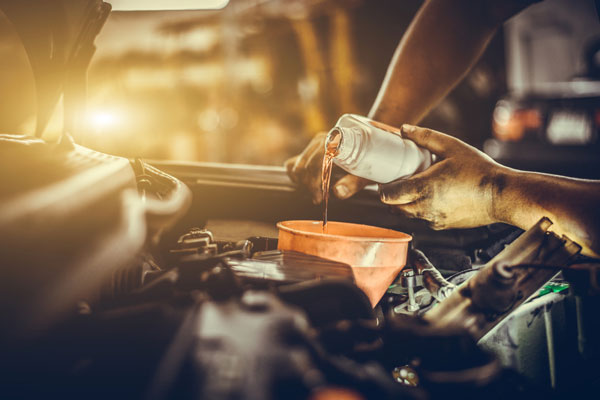
When you learned to drive a car, you probably had someone tell you it’s important to check the oil and “top off the fluids” every now and then. But what fluids were they talking about?
We’re glad you turn to us for your oil change, brake inspections, alignments and engine trouble. But, we’d like to give you some insight into the various car fluids so you can avoid coming in for preventable problems.
What Fluids Are in My Car?
First of all, there are a number of fluids in a car. All are required to keep the engine running smoothly, and all its many components. In no particular order, here’s what you need:
- Oil – The purpose of oil in a car is to keep the engine lubricated. You want all parts moving smoothly, and engine oil does the trick.
- Radiator Fluid – This fluid prevents your engine from overheating and freezing. It’s a temperature transferring fluid for your car.
- Transmission Fluid – Whether you drive an automatic or a manual, your car has transmission fluid. While the types of fluid differ, in either type of transmission, it keeps the car lubricated so it can properly function and shift gear.
- Power Steering Fluid – Newer cars have power steering, which makes it easier to turn the wheel of your car. You need this fluid to, once again, keep all the mechanisms of this function lubricated.
- Brake Fluid – Brake fluid is pressurized, and powers your brakes.
- Air Conditioning Coolant – Also known as refrigerant or Freon, coolant is needed for your car’s A/C to work.
Windshield Washer Fluid – Don’t you just love spraying off the windshield and swishing away grime with the wipers? If so, you’ll need regular washer fluid in the warmer months, and an anti-freeze version when the temperature falls.
How Do I Check Fluids in My Car?
Now that you have a run-down of what fluids are in your car, how do you check that the levels are right? While different car models and makes may have variations in the placement of these fluids, here’s a general guide to checking the fluids in your car.
- Oil – The oil reservoir is typically located under the hood, near the engine. When you check the oil, be sure the engine is cool. Near the front of the engine, you’ll see a cap that is labeled for motor oil. Next to this cap should be a dipstick. To check the oil, pull out the dipstick and wipe it clean. Reinsert all the way, then remove again. You will then be able to see the oil level on the dipstick, which has markers for full/max and minimum levels. Ideally, you want that oil closer to the max marker, and closer in color to amber.
- Radiator Fluid/Coolant – When your engine is completely cool, you can safely check radiator fluid under the hood. Under the hood, you should be able to locate a cap that reads “engine coolant” or “antifreeze.” If you pop that cap off, you should be able to see whether or not the fluid is near the top of the radiator.
- Transmission Fluid – To check your automatic transmission fluid, you may have to bring your car into a trusted auto repair shop such as ours. If your car has a dipstick, you can look at home, but if not, it’s best to leave this job to a mechanic. Your car should be running when you check transmission fluid levels.
- Power Steering Fluid – This fluid can be checked either by lifting a cap, or using a dipstick. It will depend on your car. There will be a label for power steering, and you can look to see if the liquid is near the top of the container, or if the dipstick indicates the maximum or minimum level.
- Brake Fluid – Your brake fluid cap will be labeled as such, or it may have an image of a circle. As with some of the other fluids, you can check the level by removing the cap and looking inside.
- Air Conditioning Coolant – This is another fluid best left to our auto repair experts. To accurately determine A/C coolant levels, there are a number of mechanical components and gauges to read.
- Windshield Washer Fluid – Another easy check! Your washer fluid is housed under the hood in a reservoir with a cap labeled as “washer fluid,” and/or accompanied by the image also on your wiper lever in your car. Simply remove the cap and see how high up the fluids are in this tank.
When you come to us for an oil change, alignment or anything else, feel free to ask one of our auto repair experts to take a look at your fluids. We can check the levels, as well as top off anything that is low.
Related Posts
Key Takeaways On average, passenger vehicle tires last 40,000 to 60,000 miles, depending on type, driving habits, and maintenance. Replace tires when tread depth reaches 2/32”, if damaged, or older than 10 years. Regular rotation, alignment, and proper inflation extend tire life. Aggressive driving, poor roads, and harsh weather shorten tire lifespan. Take advantage [...]
When you think about car maintenance, you probably focus on oil changes, tire rotations, and maybe even brake pad replacement. But what about your brake fluid? If you’ve ever wondered, “What does brake fluid do?” or “Why is brake fluid important?”, you’re not alone. Brake fluid might not be the most talked-about part of [...]
Is that high-pitched squeal from your brakes driving you—and everyone else—crazy? Don’t ignore it. Squeaky brakes aren’t just annoying, they’re your car’s way of saying something needs attention. Whether you're cruising through Salt Lake City or winding up Idaho’s mountain passes, here’s what’s likely going on, how you can fix it, and when it [...]





